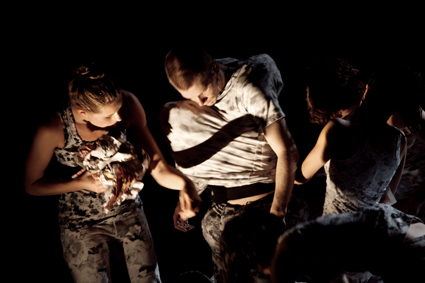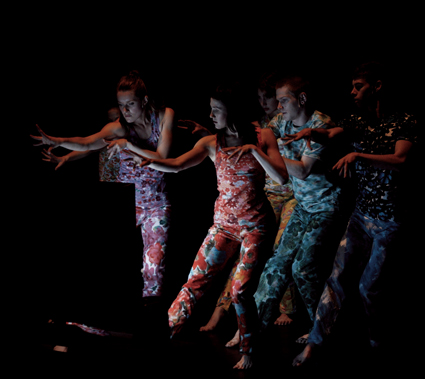 |
Human Interest Story, Lucy Guerin Inc photo Jeff Busby |
The rhythms of news broadcasting appear to infect these people, knocking them slightly off-kilter and stimulating excited physical responses: sign language-like gesturing and tightly patterned, exquisite dance moves in twos and threes with unusual manipulations. But the sense of mutual pleasure is interrupted: one of their number (Stephanie Lake) wanders to one side: “Steph, what are you doing?” “Just doing a bit of a dancing.” Unlike the others, her dance is loosely lyrical, introspective, less highly articulated. A motif takes shape as Lake peels away again and again—her head in an everyday reverie…children to look after, food…It’s a motif of attempted separation that will return darkly when the work moves to its conclusion. As the news worsens (the massive fires in Russia) and simultaneously grows sillier (Anton Enus from SBS World News Australia plays himself in a pre-recorded episode), the group dance as one, eyes on the screen, its pull evident in the almost involuntary drag of arms that lead.
As our eyes adjust we see upstage an army tank, the only substantial design element, an ominous full-scale presence. As a series of increasingly grim images unfold, the sense of imminent war or crushed resistance grows—not that the dancers pay any attention to the tank or confront or dance on it, although I expect them to at any moment. They inhabit, save for Lake’s sidestepping, an apparent closed circuit. Sunny coloured costumes are replaced by black and white outfits.
However, while Lake’s ‘dissidence’—“just dancing”—is tolerated, a sole male (Alisdair Macindoe) is soon assaulted by his fellows in a darkening, dimly lit world. Slowly and neatly, they lay out rows of newspaper pages and then stuff them into the man’s clothing until he his swollen and bulging like the Elephant Man, disabled, an object to be played with, spun on the spot, high, low and crouching, faster and faster…knocked down, left to empty himself of news. As in Guerin’s Structure and Sadness (2009) the power of dance as installation is felt—design as integral, neither mere backdrop nor frame.
 |
Human Interest Story, Lucy Guerin Inc photo Jeff Busby |
A group of dancers forms upstage, tangled, gesticulating, travelling forward in a rush, on the edge of violence, but returning and repeating the same action compulsively. One of them is Lake. As earlier, she breaks from the pattern. She combs her hair. She rejoins the group. The action resumes. Lake breaks away, this time leaving the auditorium—we hear her asked, “How’s the show going.” She returns, but this time is locked into the pattern—no escape. Meanwhile another group, on a parallel line, appears to “just dance.”
If this motif of ‘just dancing’ looks like a temporary reprieve from the horrors and the absurdities of the news, or even a kind of freedom, the show’s final image is not reassuring. The dancers cluster tightly in golden light upstage, the tank looming behind. Some gesture rhetorically, like politicians, one plays air guitar, others look up as if in awe, but there is nothing transcendent in the image, no-one breaking from the crowd or differentiated from it. No dancing.
It’s difficult to do justice to Human Interest Story from one viewing, to describe the significant role of Jethro Woodward’s gritty score or to be sure that one’s reading of this theme-driven but viscerally realised work is adequate, although the unexpectedly blunt ending appears to mesh with Guerin’s apparent pessimism. Although the early representations of the flattening of affect by the news seem protracted, Human Interest Story moves dynamically from everyday states in which we can recognise ourselves into a deeply disturbing, ever-darkening embodiment, both literal and metaphorical, of the traps set us by the contradictions of the news media. Lucy Guerin, as ever, has created a work at once cerebral and emotional, a dream turned memorable nightmare. It’s apt that Human Interest Story is part of Company B Belvoir’s mainstage program for 2011 in Sydney. That’s great news.
Lucy Guerin Inc, Human Interest Story, choreographer Lucy Guerin, performers Stephanie Lake, Alisdair Macindoe, Talitha Maslin, Harriet Ritchie, Stuart Shugg, Jessica Wong, set design Gideon Obarzanek, realising designer Anna Cordingley, costumes Paula Levis, lighting Paul Jackson, composer, sound designer Jethro Woodward; A Malthouse Theatre, Lucy Guerin Inc & Perth International Arts Festival Commission; Merlyn Theatre, Malthouse Theatre, Melbourne, July 23–Aug 1
RealTime issue #99 Oct-Nov 2010 pg. 32
© Keith Gallasch; for permission to reproduce apply to [email protected]








 back
back